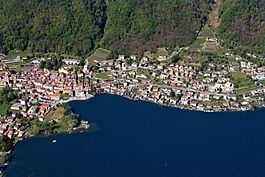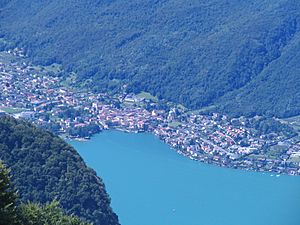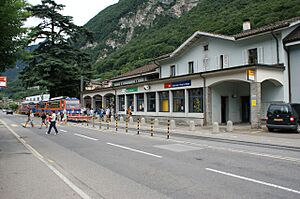Riva San Vitale facts for kids
Quick facts for kids
Riva San Vitale
|
||
|---|---|---|
 |
||
|
||
| Country | Switzerland | |
| Canton | Ticino | |
| District | Mendrisio | |
| Area | ||
| • Total | 6.08 km2 (2.35 sq mi) | |
| Elevation | 273 m (896 ft) | |
| Population
(Dec 2020 )
|
||
| • Total | 2,626 | |
| • Density | 431.9/km2 (1,118.6/sq mi) | |
| Postal code |
6826
|
|
| Surrounded by | Bissone, Brusino Arsizio, Capolago, Maroggia, Melano, Mendrisio, Meride, Rancate, Tremona | |
Riva San Vitale is a charming town in the canton of Ticino, Switzerland. It is located in the Mendrisio district. This municipality is known for its rich history and beautiful natural setting.
Contents
A Look at Riva San Vitale's Past
Riva San Vitale was first mentioned in old records in the year 774. Back then, it was called Primo Sobenno. Later, in 1115, it was known as Ripa Sancti Vitalis.
People have likely lived in this area since the Neolithic Age, which was a very long time ago. Many items from the Roman era have been found here. This suggests that a large Roman settlement once existed. An old stone monument, called a stele, from before 300 AD, mentions that it was made for the people of vicus subinates, a small Roman village.
In 1115, a group of monks from the S. Abbondio abbey in Como owned land in Riva San Vitale. During a ten-year war between Como and Milan (1118–1127), the town's port was very important for Como's ships. In 1335, Riva San Vitale was called a burgus, which means a fortified town or borough.
Later, in the Late Middle Ages, Riva San Vitale became less important for trade than Capolago. However, it still had special rights and did not have to pay certain taxes. For a short time in the 15th century, it was even a market town.
Important Old Buildings
The Parish Church of St. Vitale was first mentioned between 962 and 966. However, it is probably much older, dating back to when Christianity first came to the southern Alps. The church was rebuilt in the Baroque style between 1756 and 1759. It was also updated in the 1990s.
The Baptistery of San Giovanni is built on the remains of a Roman building. It dates back to the early Christian period, around 500 AD. This makes it the oldest fully preserved church in Switzerland! It was restored in the 1920s and 1950s.
The Church of S. Croce was built between 1582 and 1591. It was funded by the Della Croce family. This church is one of the most important religious buildings from the late Renaissance in Switzerland.
How People Used to Make a Living
In the past, people in Riva San Vitale mainly earned money from farming, fishing, and making bricks. In 1869, a silk weaving factory opened in Segoma. By 1889, about 100 people worked there.
In the second half of the 20th century, Riva San Vitale saw a big increase in industries. This led to more people moving to the town. By 2000, about three-quarters of the workers traveled to jobs outside the municipality. Many went to Lugano, Mendrisio, and Chiasso.
In 2005, the manufacturing sector provided 45% of all jobs. The services sector, like shops and offices, provided 52% of jobs. The Collegio Baragiola building was a secondary school from 1855 to 1925. In 1926, it became the Istituto Canisio, a special school for people with disabilities.
Transportation in the Past
In 1910, the Mendrisio electric tramway opened. This tram connected Riva San Vitale with Capolago, Mendrisio, Balerna, and Chiasso. The tram line in Riva San Vitale closed in 1948. After that, buses took over the service.
The Pieve of Riva San Vitale
Riva San Vitale was one of the oldest important centers for the diocese of Como. It was part of this diocese until the late 1800s. Christianity spread from here into the Ticino region.
The Pieve was also a local government area. In 1170, it was part of the county of Seprio. In the 13th century, it was under the city of Como. In the early 15th century, it joined with other areas to form the Lugano Valley Community.
In 1517, when the Swiss Confederation took control, it became part of the bailiwick of Lugano. The Pieve of Riva San Vitale had representatives in the valley's general meetings. These meetings handled money, taxes, and salt supply. They also had a say in the valley's administrative body.
After a failed attempt to join the Cisalpine Republic in 1798, the Pieve formed its own "Republic of Riva San Vitale." This republic only lasted a few weeks, from February 23 to March 16, 1798. In 1803, the Pieve of Riva San Vitale was added to the Lugano district. It was then divided into two parts: Ceresio and Riva San Vitale. In 1814, they became part of the Mendrisio district.
Geography and Nature
Riva San Vitale covers an area of about 5.97 square kilometers (2.3 square miles). A large part of this area, about 73.2%, is covered by forests. About 19.6% of the land is used for farming.
The town itself, with its buildings and roads, makes up about 14.7% of the area. A small part, 1.3%, is made up of rivers or lakes. Only 0.5% of the land is unproductive.
Riva San Vitale is located in the Mendrisio district. It sits at the southern end of Lake Lugano. It is also at the foot of Monte San Giorgio, a famous mountain. The municipality includes the main village of Riva San Vitale and a smaller village called Poiana.
Town Symbol: The Coat of Arms
The blazon (description) of Riva San Vitale's municipal coat of arms is: "Red, an arm coming out from the right, wearing silver armor, bent at the elbow, holding a gold-hilted and gold-pommeled sword."
People of Riva San Vitale
Riva San Vitale has a population of about 2,654 people (as of 2020). In 2008, about 16.4% of the people living here were foreign nationals. Between 1997 and 2007, the population grew by 10.4%.
In 2000, most people (91.1%) spoke Italian. German was the second most common language (5.1%), and French was third (1.0%).
In 2008, about 48.9% of the population was male and 51.1% was female. Most people (about 38.8%) were born in Riva San Vitale. About 28.3% were born in the same canton. About 21.4% were born outside of Switzerland.
The age distribution in 2009 showed that about 8.4% of the population were children aged 0-9. Teenagers aged 10-19 made up about 11.7%. Adults aged 20-59 made up about 55.3% of the population. People aged 60 and older made up about 24.5%.
In 2000, there were 924 private households in the municipality. On average, there were 2.4 people per household. About 26.7% of households had only one person.
In 2000, there were 699 inhabited buildings in Riva San Vitale. About 67.5% of these were single-family homes. The most common apartment size was four rooms. Most apartments (80.3%) were lived in all year round.
Important Cultural Sites
Riva San Vitale has several important historical buildings. The Baptistery of S. Giovanni, the Bianchi House, the Church of S. Croce, and the Palazzo della Croce are all listed as Swiss heritage sites of national significance. This means they are very important to Switzerland's history and culture. The entire town of Riva San Vitale is also part of the Inventory of Swiss Heritage Sites.
Economy and Jobs
In 2007, the unemployment rate in Riva San Vitale was 3.25%. In 2005, about 31 people worked in the primary economic sector, which includes farming and forestry. About 322 people worked in the secondary sector, like manufacturing and construction. The largest number, 370 people, worked in the tertiary sector, which includes services like shops, hotels, and education.
In 2008, there were 656 full-time equivalent jobs in the municipality. Many jobs were in manufacturing (62.4% of secondary sector jobs) and construction (35.0%). In the services sector, many jobs were in education (35.9%) and sales (24.6%).
In 2000, 843 workers came into Riva San Vitale for work, and 817 workers left to work elsewhere. This means more people came into the town for jobs than left it. About 9.5% of workers used public transportation, and 62.1% used a private car to get to work.
Getting Around
Riva San Vitale is served by the Capolago-Riva San Vitale railway station. This station is on the Gotthardbahn railway line. It is located about 1 kilometer away in the nearby town of Capolago. Buses from Autolinea Mendrisiense connect Riva San Vitale to the station and other towns like Brusino Arsizio, Mendrisio, and Porto Ceresio.
Religion in the Community
According to the 2000 census, most people in Riva San Vitale (83.5%) were Roman Catholic. About 3.8% belonged to the Swiss Reformed Church. A small number of people belonged to other Christian churches, or were Islamic, Buddhist, or Hindu. About 5.8% of the population did not belong to any church.
Learning and Education
In Riva San Vitale, about 40.7% of the population has completed upper secondary education. About 10.1% have completed higher education, like university or a specialized college.
In 2009, there were 428 students in Riva San Vitale. The education system in Ticino offers up to three years of optional kindergarten. There were 59 children in kindergarten here. The primary school program lasts five years. In Riva San Vitale, 117 students attended standard primary schools.
For middle school, students can choose between a two-year program followed by a pre-apprenticeship, or a four-year program to prepare for higher education. There were 114 students in the two-year middle school program.
After middle school, students can go to upper secondary school. This prepares them for a trade or for university. In 2009, there were 31 full-time and 44 part-time vocational students. There were also 5 students in a professional program, which prepares them for jobs in fields like engineering or nursing.
In 2000, 321 students came to Riva San Vitale from other towns for school. At the same time, 95 residents went to schools outside the municipality.
Virginia Tech's Steger Center
A branch of an American university, Virginia Tech's Steger Center for International Scholarship, is located in Riva San Vitale. It is housed in the historic Villa Maderni, which is 250 years old. This center is Virginia Tech's European campus.
The Steger Center offers different academic programs for university students. Its main program is a semester-long stay where students live in Riva San Vitale. They attend classes in the Villa Maderni and go on field trips around Europe. The center also has summer study-abroad programs.
See also
 In Spanish: Riva San Vitale para niños
In Spanish: Riva San Vitale para niños














